Suitable Routing Protocols for FANET
VerifiedAdded on 2021/04/16
|9
|2000
|42
AI Summary
This assignment involves studying the evolving nature of Flying Ad Hoc Networks (FANET), which is characterized by frequent topology changes, 3D spatial movement of UAVs, and colossal mobility. The focus is on finding reliable and suitable routing protocols that can handle drastic communication among UAVs, considering parameters like packet forwarding mechanism, routing overhead, traffic density, and mobility. A simulation-based study will be conducted to evaluate multiple topology-based routing protocols, prioritizing end-to-end delay and network load. This research aims to provide valuable insights for network engineers to select the most suitable routing protocols in various scenarios, making FANET technology more ubiquitous for future applications.
Contribute Materials
Your contribution can guide someone’s learning journey. Share your
documents today.

Running head: FLYING AD-HOC NETWORK
Flying ad-hoc network
Name of the student:
Name of the university:
Author Note
Flying ad-hoc network
Name of the student:
Name of the university:
Author Note
Secure Best Marks with AI Grader
Need help grading? Try our AI Grader for instant feedback on your assignments.
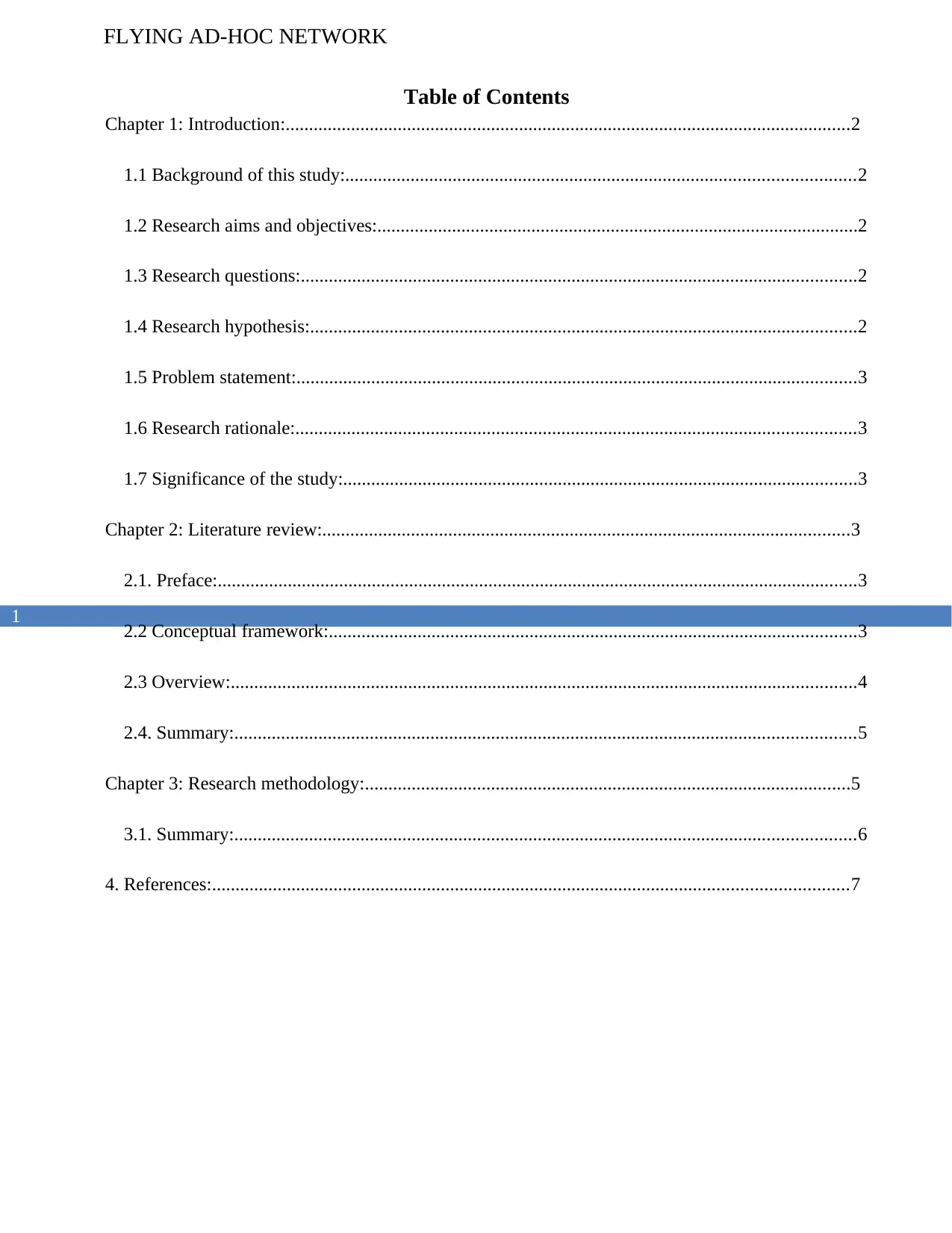
FLYING AD-HOC NETWORK
1
Table of Contents
Chapter 1: Introduction:.........................................................................................................................2
1.1 Background of this study:.............................................................................................................2
1.2 Research aims and objectives:.......................................................................................................2
1.3 Research questions:.......................................................................................................................2
1.4 Research hypothesis:.....................................................................................................................2
1.5 Problem statement:........................................................................................................................3
1.6 Research rationale:........................................................................................................................3
1.7 Significance of the study:..............................................................................................................3
Chapter 2: Literature review:.................................................................................................................3
2.1. Preface:.........................................................................................................................................3
2.2 Conceptual framework:.................................................................................................................3
2.3 Overview:......................................................................................................................................4
2.4. Summary:.....................................................................................................................................5
Chapter 3: Research methodology:........................................................................................................5
3.1. Summary:.....................................................................................................................................6
4. References:........................................................................................................................................7
1
Table of Contents
Chapter 1: Introduction:.........................................................................................................................2
1.1 Background of this study:.............................................................................................................2
1.2 Research aims and objectives:.......................................................................................................2
1.3 Research questions:.......................................................................................................................2
1.4 Research hypothesis:.....................................................................................................................2
1.5 Problem statement:........................................................................................................................3
1.6 Research rationale:........................................................................................................................3
1.7 Significance of the study:..............................................................................................................3
Chapter 2: Literature review:.................................................................................................................3
2.1. Preface:.........................................................................................................................................3
2.2 Conceptual framework:.................................................................................................................3
2.3 Overview:......................................................................................................................................4
2.4. Summary:.....................................................................................................................................5
Chapter 3: Research methodology:........................................................................................................5
3.1. Summary:.....................................................................................................................................6
4. References:........................................................................................................................................7
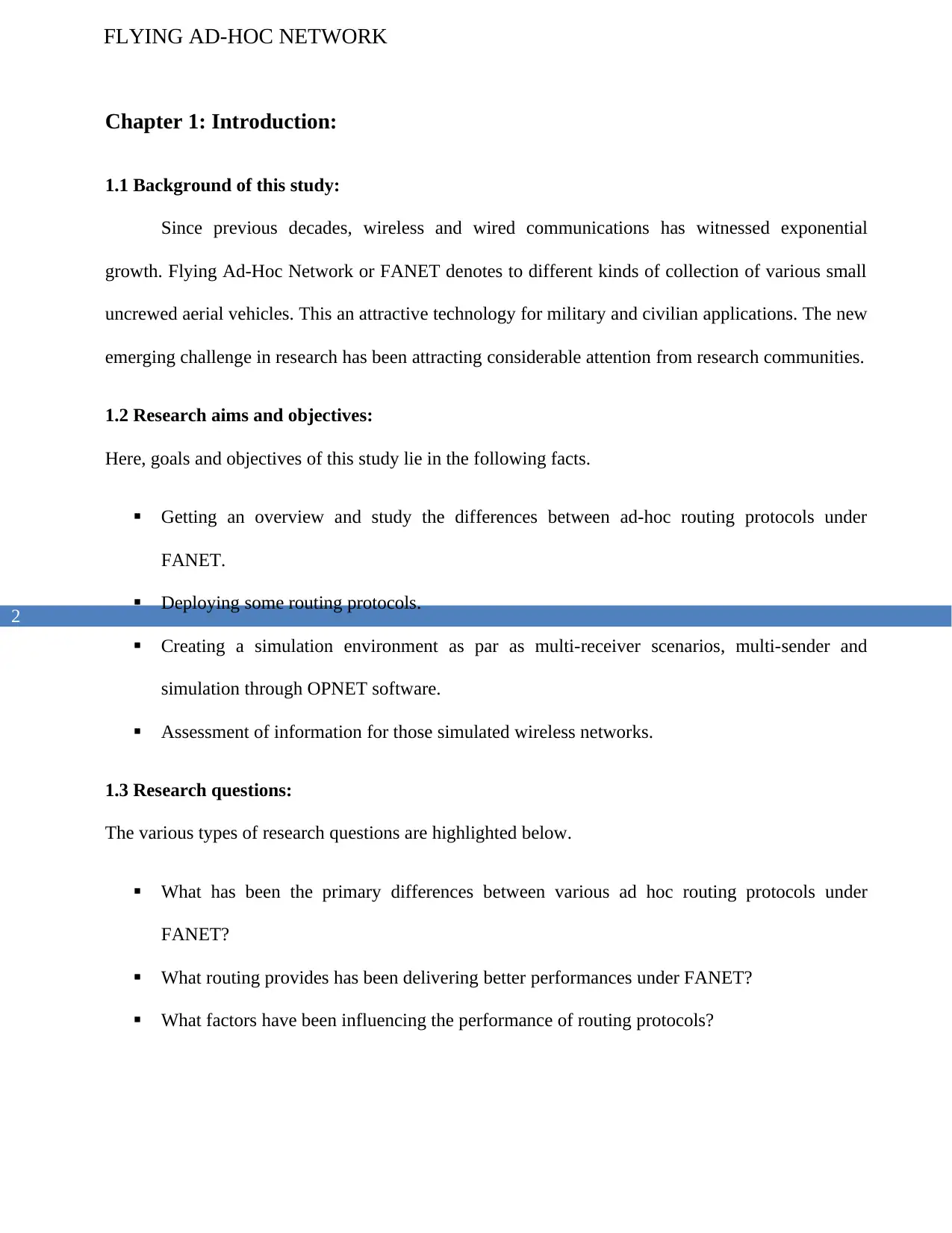
FLYING AD-HOC NETWORK
2
Chapter 1: Introduction:
1.1 Background of this study:
Since previous decades, wireless and wired communications has witnessed exponential
growth. Flying Ad-Hoc Network or FANET denotes to different kinds of collection of various small
uncrewed aerial vehicles. This an attractive technology for military and civilian applications. The new
emerging challenge in research has been attracting considerable attention from research communities.
1.2 Research aims and objectives:
Here, goals and objectives of this study lie in the following facts.
Getting an overview and study the differences between ad-hoc routing protocols under
FANET.
Deploying some routing protocols.
Creating a simulation environment as par as multi-receiver scenarios, multi-sender and
simulation through OPNET software.
Assessment of information for those simulated wireless networks.
1.3 Research questions:
The various types of research questions are highlighted below.
What has been the primary differences between various ad hoc routing protocols under
FANET?
What routing provides has been delivering better performances under FANET?
What factors have been influencing the performance of routing protocols?
2
Chapter 1: Introduction:
1.1 Background of this study:
Since previous decades, wireless and wired communications has witnessed exponential
growth. Flying Ad-Hoc Network or FANET denotes to different kinds of collection of various small
uncrewed aerial vehicles. This an attractive technology for military and civilian applications. The new
emerging challenge in research has been attracting considerable attention from research communities.
1.2 Research aims and objectives:
Here, goals and objectives of this study lie in the following facts.
Getting an overview and study the differences between ad-hoc routing protocols under
FANET.
Deploying some routing protocols.
Creating a simulation environment as par as multi-receiver scenarios, multi-sender and
simulation through OPNET software.
Assessment of information for those simulated wireless networks.
1.3 Research questions:
The various types of research questions are highlighted below.
What has been the primary differences between various ad hoc routing protocols under
FANET?
What routing provides has been delivering better performances under FANET?
What factors have been influencing the performance of routing protocols?
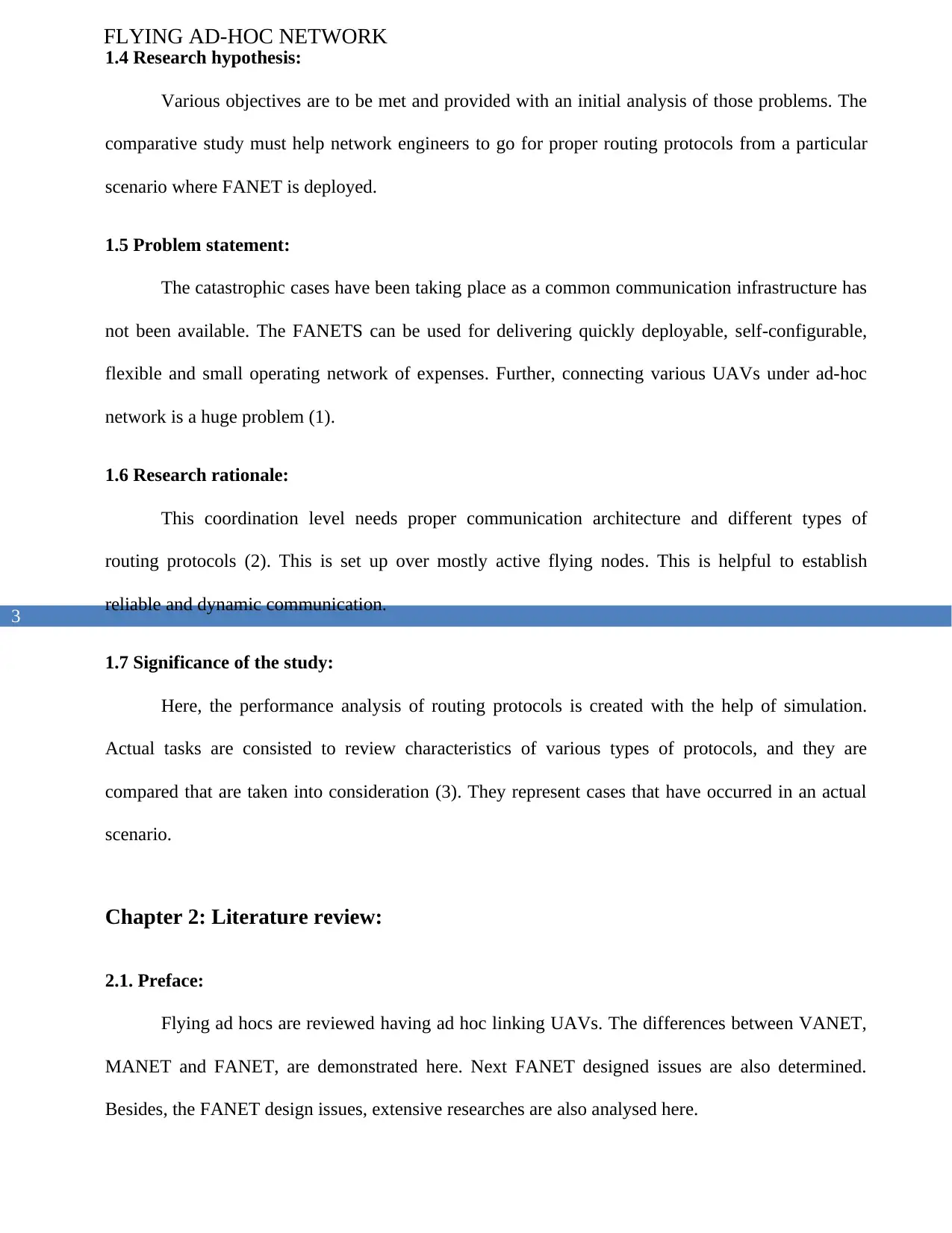
FLYING AD-HOC NETWORK
3
1.4 Research hypothesis:
Various objectives are to be met and provided with an initial analysis of those problems. The
comparative study must help network engineers to go for proper routing protocols from a particular
scenario where FANET is deployed.
1.5 Problem statement:
The catastrophic cases have been taking place as a common communication infrastructure has
not been available. The FANETS can be used for delivering quickly deployable, self-configurable,
flexible and small operating network of expenses. Further, connecting various UAVs under ad-hoc
network is a huge problem (1).
1.6 Research rationale:
This coordination level needs proper communication architecture and different types of
routing protocols (2). This is set up over mostly active flying nodes. This is helpful to establish
reliable and dynamic communication.
1.7 Significance of the study:
Here, the performance analysis of routing protocols is created with the help of simulation.
Actual tasks are consisted to review characteristics of various types of protocols, and they are
compared that are taken into consideration (3). They represent cases that have occurred in an actual
scenario.
Chapter 2: Literature review:
2.1. Preface:
Flying ad hocs are reviewed having ad hoc linking UAVs. The differences between VANET,
MANET and FANET, are demonstrated here. Next FANET designed issues are also determined.
Besides, the FANET design issues, extensive researches are also analysed here.
3
1.4 Research hypothesis:
Various objectives are to be met and provided with an initial analysis of those problems. The
comparative study must help network engineers to go for proper routing protocols from a particular
scenario where FANET is deployed.
1.5 Problem statement:
The catastrophic cases have been taking place as a common communication infrastructure has
not been available. The FANETS can be used for delivering quickly deployable, self-configurable,
flexible and small operating network of expenses. Further, connecting various UAVs under ad-hoc
network is a huge problem (1).
1.6 Research rationale:
This coordination level needs proper communication architecture and different types of
routing protocols (2). This is set up over mostly active flying nodes. This is helpful to establish
reliable and dynamic communication.
1.7 Significance of the study:
Here, the performance analysis of routing protocols is created with the help of simulation.
Actual tasks are consisted to review characteristics of various types of protocols, and they are
compared that are taken into consideration (3). They represent cases that have occurred in an actual
scenario.
Chapter 2: Literature review:
2.1. Preface:
Flying ad hocs are reviewed having ad hoc linking UAVs. The differences between VANET,
MANET and FANET, are demonstrated here. Next FANET designed issues are also determined.
Besides, the FANET design issues, extensive researches are also analysed here.
Secure Best Marks with AI Grader
Need help grading? Try our AI Grader for instant feedback on your assignments.
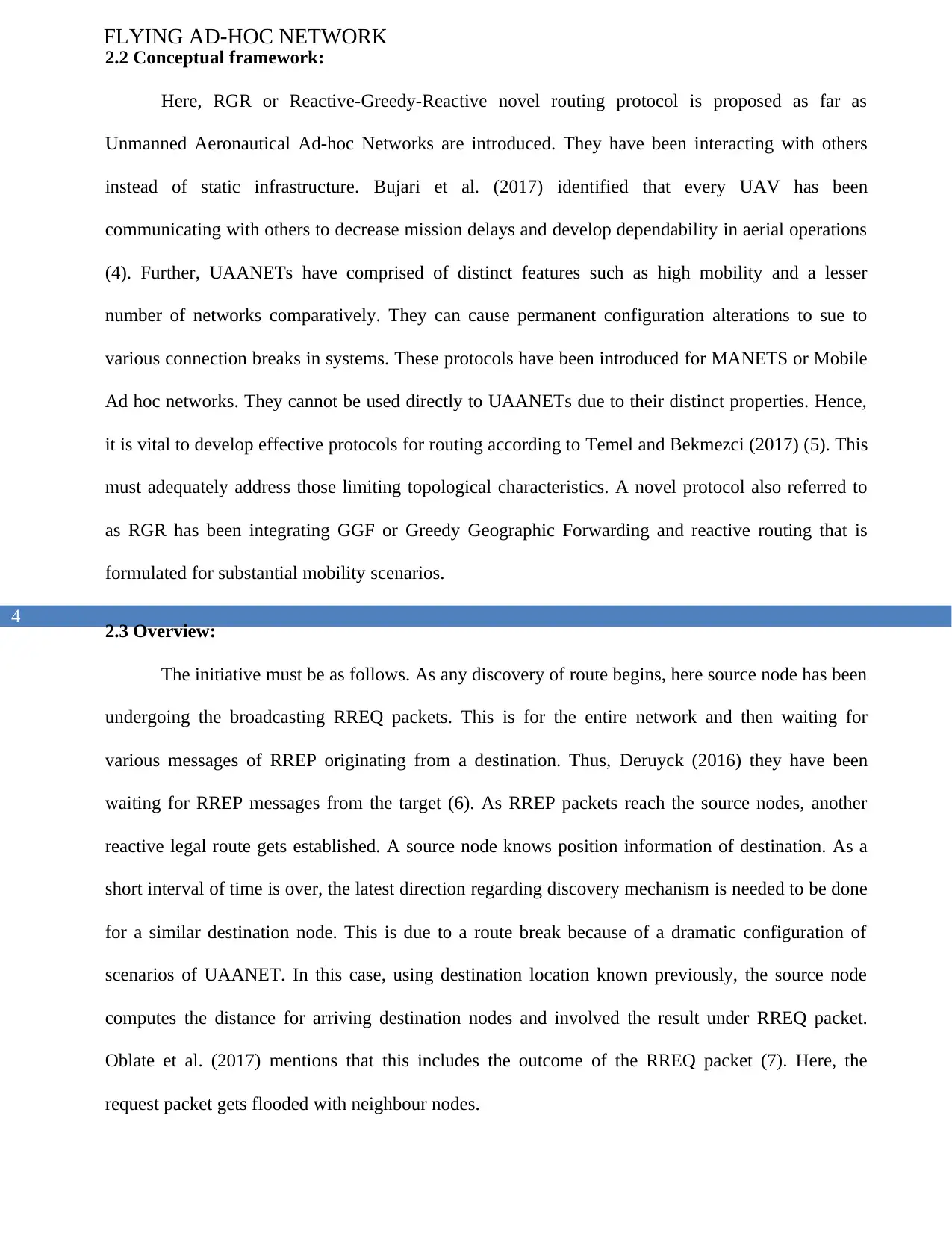
FLYING AD-HOC NETWORK
4
2.2 Conceptual framework:
Here, RGR or Reactive-Greedy-Reactive novel routing protocol is proposed as far as
Unmanned Aeronautical Ad-hoc Networks are introduced. They have been interacting with others
instead of static infrastructure. Bujari et al. (2017) identified that every UAV has been
communicating with others to decrease mission delays and develop dependability in aerial operations
(4). Further, UAANETs have comprised of distinct features such as high mobility and a lesser
number of networks comparatively. They can cause permanent configuration alterations to sue to
various connection breaks in systems. These protocols have been introduced for MANETS or Mobile
Ad hoc networks. They cannot be used directly to UAANETs due to their distinct properties. Hence,
it is vital to develop effective protocols for routing according to Temel and Bekmezci (2017) (5). This
must adequately address those limiting topological characteristics. A novel protocol also referred to
as RGR has been integrating GGF or Greedy Geographic Forwarding and reactive routing that is
formulated for substantial mobility scenarios.
2.3 Overview:
The initiative must be as follows. As any discovery of route begins, here source node has been
undergoing the broadcasting RREQ packets. This is for the entire network and then waiting for
various messages of RREP originating from a destination. Thus, Deruyck (2016) they have been
waiting for RREP messages from the target (6). As RREP packets reach the source nodes, another
reactive legal route gets established. A source node knows position information of destination. As a
short interval of time is over, the latest direction regarding discovery mechanism is needed to be done
for a similar destination node. This is due to a route break because of a dramatic configuration of
scenarios of UAANET. In this case, using destination location known previously, the source node
computes the distance for arriving destination nodes and involved the result under RREQ packet.
Oblate et al. (2017) mentions that this includes the outcome of the RREQ packet (7). Here, the
request packet gets flooded with neighbour nodes.
4
2.2 Conceptual framework:
Here, RGR or Reactive-Greedy-Reactive novel routing protocol is proposed as far as
Unmanned Aeronautical Ad-hoc Networks are introduced. They have been interacting with others
instead of static infrastructure. Bujari et al. (2017) identified that every UAV has been
communicating with others to decrease mission delays and develop dependability in aerial operations
(4). Further, UAANETs have comprised of distinct features such as high mobility and a lesser
number of networks comparatively. They can cause permanent configuration alterations to sue to
various connection breaks in systems. These protocols have been introduced for MANETS or Mobile
Ad hoc networks. They cannot be used directly to UAANETs due to their distinct properties. Hence,
it is vital to develop effective protocols for routing according to Temel and Bekmezci (2017) (5). This
must adequately address those limiting topological characteristics. A novel protocol also referred to
as RGR has been integrating GGF or Greedy Geographic Forwarding and reactive routing that is
formulated for substantial mobility scenarios.
2.3 Overview:
The initiative must be as follows. As any discovery of route begins, here source node has been
undergoing the broadcasting RREQ packets. This is for the entire network and then waiting for
various messages of RREP originating from a destination. Thus, Deruyck (2016) they have been
waiting for RREP messages from the target (6). As RREP packets reach the source nodes, another
reactive legal route gets established. A source node knows position information of destination. As a
short interval of time is over, the latest direction regarding discovery mechanism is needed to be done
for a similar destination node. This is due to a route break because of a dramatic configuration of
scenarios of UAANET. In this case, using destination location known previously, the source node
computes the distance for arriving destination nodes and involved the result under RREQ packet.
Oblate et al. (2017) mentions that this includes the outcome of the RREQ packet (7). Here, the
request packet gets flooded with neighbour nodes.
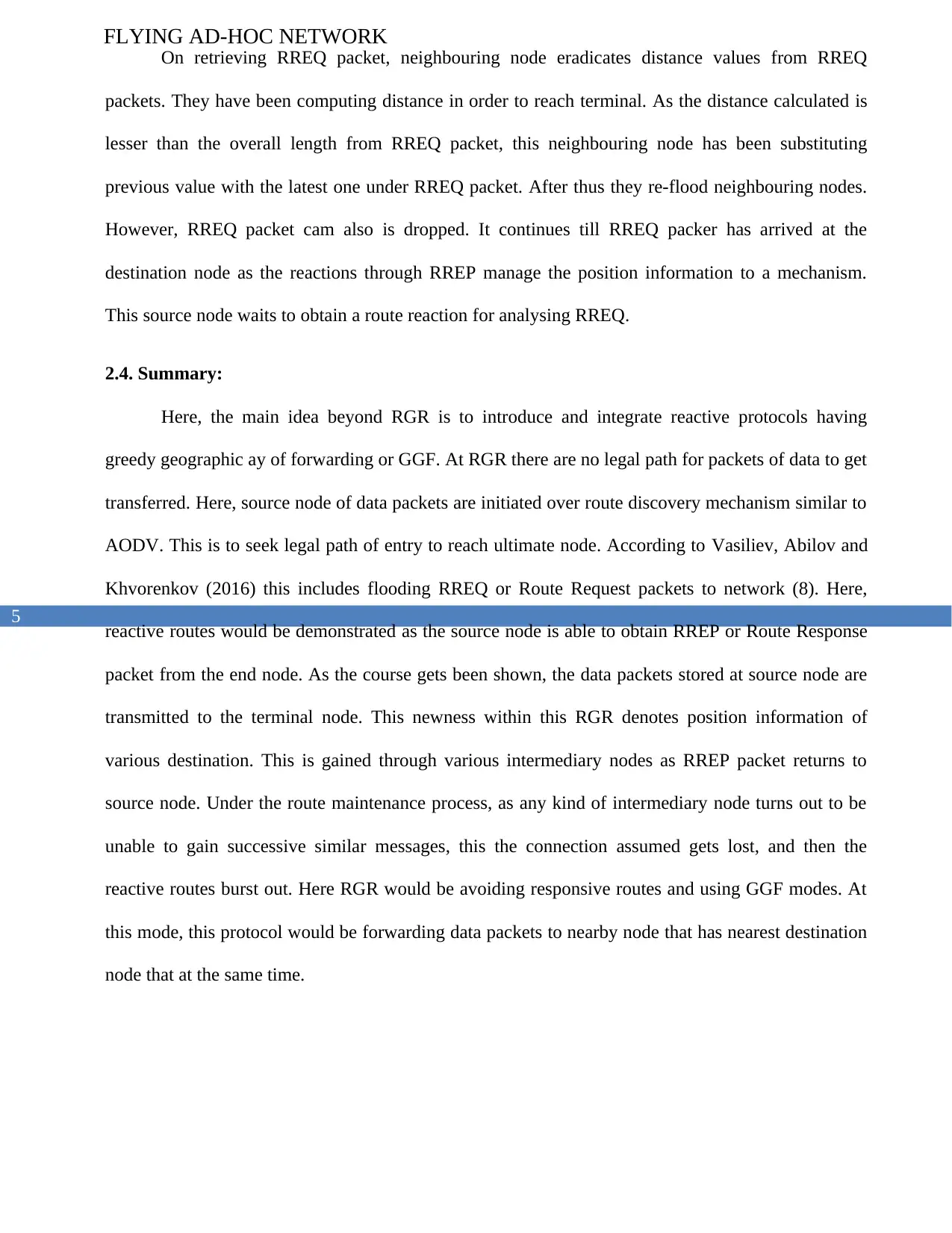
FLYING AD-HOC NETWORK
5
On retrieving RREQ packet, neighbouring node eradicates distance values from RREQ
packets. They have been computing distance in order to reach terminal. As the distance calculated is
lesser than the overall length from RREQ packet, this neighbouring node has been substituting
previous value with the latest one under RREQ packet. After thus they re-flood neighbouring nodes.
However, RREQ packet cam also is dropped. It continues till RREQ packer has arrived at the
destination node as the reactions through RREP manage the position information to a mechanism.
This source node waits to obtain a route reaction for analysing RREQ.
2.4. Summary:
Here, the main idea beyond RGR is to introduce and integrate reactive protocols having
greedy geographic ay of forwarding or GGF. At RGR there are no legal path for packets of data to get
transferred. Here, source node of data packets are initiated over route discovery mechanism similar to
AODV. This is to seek legal path of entry to reach ultimate node. According to Vasiliev, Abilov and
Khvorenkov (2016) this includes flooding RREQ or Route Request packets to network (8). Here,
reactive routes would be demonstrated as the source node is able to obtain RREP or Route Response
packet from the end node. As the course gets been shown, the data packets stored at source node are
transmitted to the terminal node. This newness within this RGR denotes position information of
various destination. This is gained through various intermediary nodes as RREP packet returns to
source node. Under the route maintenance process, as any kind of intermediary node turns out to be
unable to gain successive similar messages, this the connection assumed gets lost, and then the
reactive routes burst out. Here RGR would be avoiding responsive routes and using GGF modes. At
this mode, this protocol would be forwarding data packets to nearby node that has nearest destination
node that at the same time.
5
On retrieving RREQ packet, neighbouring node eradicates distance values from RREQ
packets. They have been computing distance in order to reach terminal. As the distance calculated is
lesser than the overall length from RREQ packet, this neighbouring node has been substituting
previous value with the latest one under RREQ packet. After thus they re-flood neighbouring nodes.
However, RREQ packet cam also is dropped. It continues till RREQ packer has arrived at the
destination node as the reactions through RREP manage the position information to a mechanism.
This source node waits to obtain a route reaction for analysing RREQ.
2.4. Summary:
Here, the main idea beyond RGR is to introduce and integrate reactive protocols having
greedy geographic ay of forwarding or GGF. At RGR there are no legal path for packets of data to get
transferred. Here, source node of data packets are initiated over route discovery mechanism similar to
AODV. This is to seek legal path of entry to reach ultimate node. According to Vasiliev, Abilov and
Khvorenkov (2016) this includes flooding RREQ or Route Request packets to network (8). Here,
reactive routes would be demonstrated as the source node is able to obtain RREP or Route Response
packet from the end node. As the course gets been shown, the data packets stored at source node are
transmitted to the terminal node. This newness within this RGR denotes position information of
various destination. This is gained through various intermediary nodes as RREP packet returns to
source node. Under the route maintenance process, as any kind of intermediary node turns out to be
unable to gain successive similar messages, this the connection assumed gets lost, and then the
reactive routes burst out. Here RGR would be avoiding responsive routes and using GGF modes. At
this mode, this protocol would be forwarding data packets to nearby node that has nearest destination
node that at the same time.
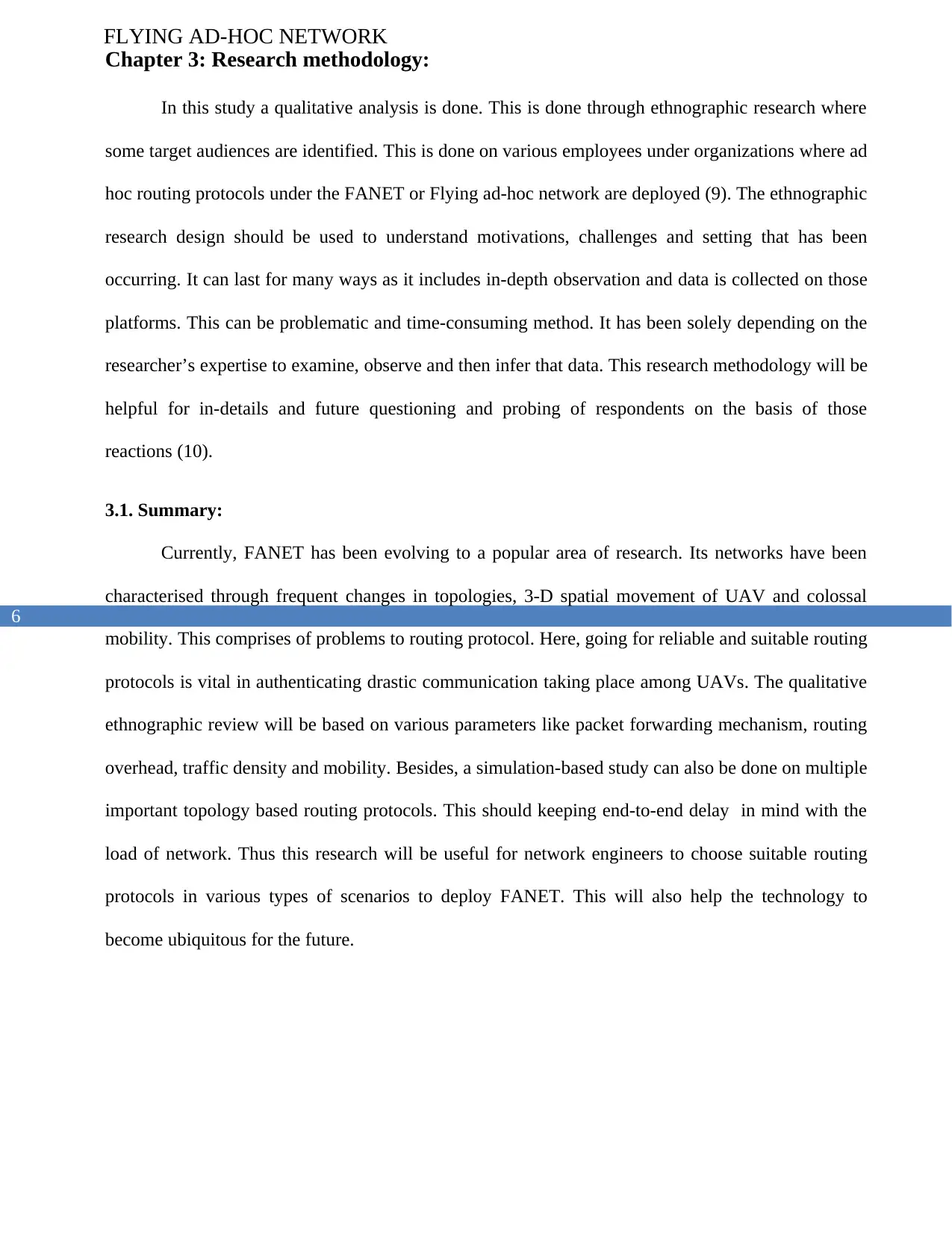
FLYING AD-HOC NETWORK
6
Chapter 3: Research methodology:
In this study a qualitative analysis is done. This is done through ethnographic research where
some target audiences are identified. This is done on various employees under organizations where ad
hoc routing protocols under the FANET or Flying ad-hoc network are deployed (9). The ethnographic
research design should be used to understand motivations, challenges and setting that has been
occurring. It can last for many ways as it includes in-depth observation and data is collected on those
platforms. This can be problematic and time-consuming method. It has been solely depending on the
researcher’s expertise to examine, observe and then infer that data. This research methodology will be
helpful for in-details and future questioning and probing of respondents on the basis of those
reactions (10).
3.1. Summary:
Currently, FANET has been evolving to a popular area of research. Its networks have been
characterised through frequent changes in topologies, 3-D spatial movement of UAV and colossal
mobility. This comprises of problems to routing protocol. Here, going for reliable and suitable routing
protocols is vital in authenticating drastic communication taking place among UAVs. The qualitative
ethnographic review will be based on various parameters like packet forwarding mechanism, routing
overhead, traffic density and mobility. Besides, a simulation-based study can also be done on multiple
important topology based routing protocols. This should keeping end-to-end delay in mind with the
load of network. Thus this research will be useful for network engineers to choose suitable routing
protocols in various types of scenarios to deploy FANET. This will also help the technology to
become ubiquitous for the future.
6
Chapter 3: Research methodology:
In this study a qualitative analysis is done. This is done through ethnographic research where
some target audiences are identified. This is done on various employees under organizations where ad
hoc routing protocols under the FANET or Flying ad-hoc network are deployed (9). The ethnographic
research design should be used to understand motivations, challenges and setting that has been
occurring. It can last for many ways as it includes in-depth observation and data is collected on those
platforms. This can be problematic and time-consuming method. It has been solely depending on the
researcher’s expertise to examine, observe and then infer that data. This research methodology will be
helpful for in-details and future questioning and probing of respondents on the basis of those
reactions (10).
3.1. Summary:
Currently, FANET has been evolving to a popular area of research. Its networks have been
characterised through frequent changes in topologies, 3-D spatial movement of UAV and colossal
mobility. This comprises of problems to routing protocol. Here, going for reliable and suitable routing
protocols is vital in authenticating drastic communication taking place among UAVs. The qualitative
ethnographic review will be based on various parameters like packet forwarding mechanism, routing
overhead, traffic density and mobility. Besides, a simulation-based study can also be done on multiple
important topology based routing protocols. This should keeping end-to-end delay in mind with the
load of network. Thus this research will be useful for network engineers to choose suitable routing
protocols in various types of scenarios to deploy FANET. This will also help the technology to
become ubiquitous for the future.
Paraphrase This Document
Need a fresh take? Get an instant paraphrase of this document with our AI Paraphraser
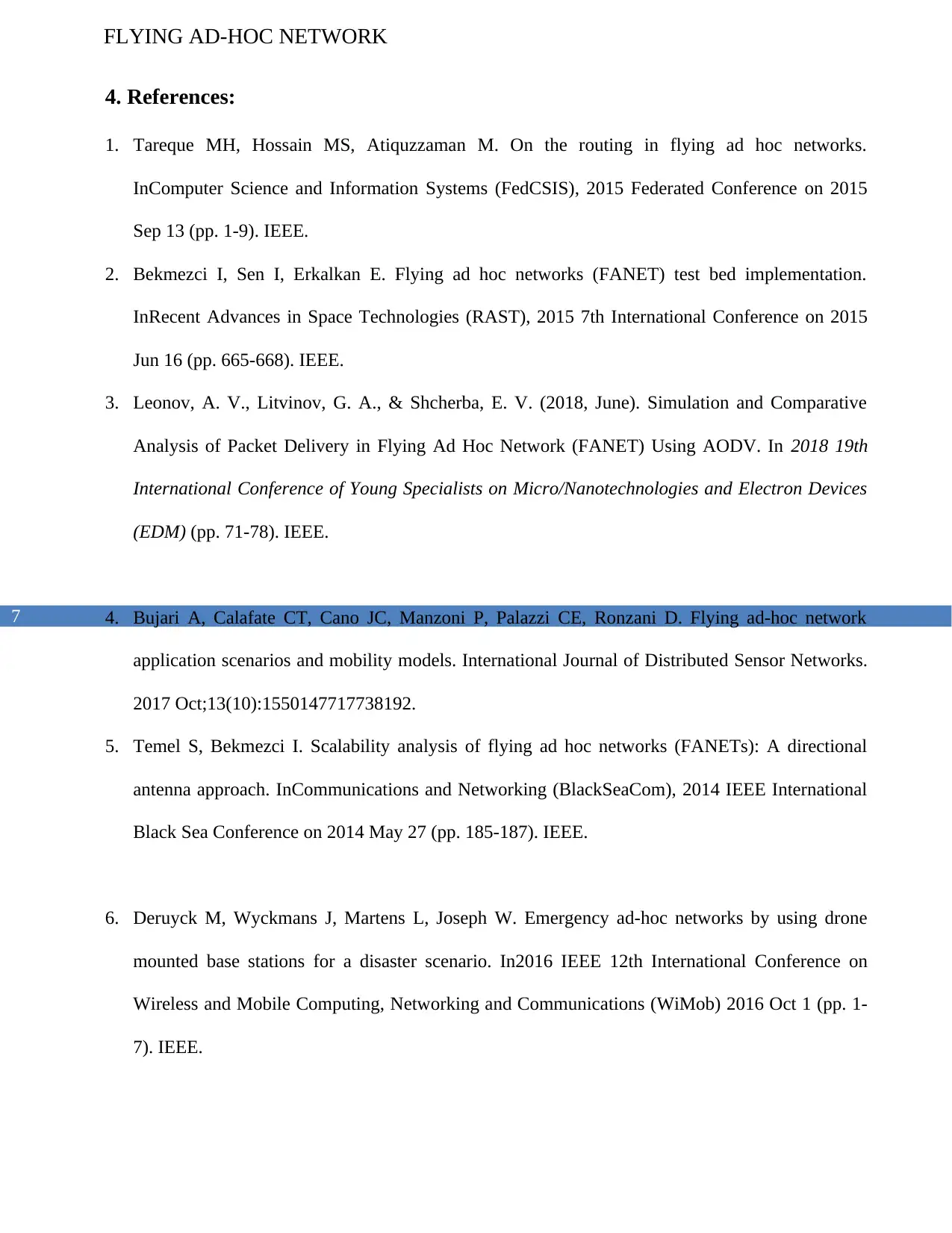
FLYING AD-HOC NETWORK
7
4. References:
1. Tareque MH, Hossain MS, Atiquzzaman M. On the routing in flying ad hoc networks.
InComputer Science and Information Systems (FedCSIS), 2015 Federated Conference on 2015
Sep 13 (pp. 1-9). IEEE.
2. Bekmezci I, Sen I, Erkalkan E. Flying ad hoc networks (FANET) test bed implementation.
InRecent Advances in Space Technologies (RAST), 2015 7th International Conference on 2015
Jun 16 (pp. 665-668). IEEE.
3. Leonov, A. V., Litvinov, G. A., & Shcherba, E. V. (2018, June). Simulation and Comparative
Analysis of Packet Delivery in Flying Ad Hoc Network (FANET) Using AODV. In 2018 19th
International Conference of Young Specialists on Micro/Nanotechnologies and Electron Devices
(EDM) (pp. 71-78). IEEE.
4. Bujari A, Calafate CT, Cano JC, Manzoni P, Palazzi CE, Ronzani D. Flying ad-hoc network
application scenarios and mobility models. International Journal of Distributed Sensor Networks.
2017 Oct;13(10):1550147717738192.
5. Temel S, Bekmezci I. Scalability analysis of flying ad hoc networks (FANETs): A directional
antenna approach. InCommunications and Networking (BlackSeaCom), 2014 IEEE International
Black Sea Conference on 2014 May 27 (pp. 185-187). IEEE.
6. Deruyck M, Wyckmans J, Martens L, Joseph W. Emergency ad-hoc networks by using drone
mounted base stations for a disaster scenario. In2016 IEEE 12th International Conference on
Wireless and Mobile Computing, Networking and Communications (WiMob) 2016 Oct 1 (pp. 1-
7). IEEE.
7
4. References:
1. Tareque MH, Hossain MS, Atiquzzaman M. On the routing in flying ad hoc networks.
InComputer Science and Information Systems (FedCSIS), 2015 Federated Conference on 2015
Sep 13 (pp. 1-9). IEEE.
2. Bekmezci I, Sen I, Erkalkan E. Flying ad hoc networks (FANET) test bed implementation.
InRecent Advances in Space Technologies (RAST), 2015 7th International Conference on 2015
Jun 16 (pp. 665-668). IEEE.
3. Leonov, A. V., Litvinov, G. A., & Shcherba, E. V. (2018, June). Simulation and Comparative
Analysis of Packet Delivery in Flying Ad Hoc Network (FANET) Using AODV. In 2018 19th
International Conference of Young Specialists on Micro/Nanotechnologies and Electron Devices
(EDM) (pp. 71-78). IEEE.
4. Bujari A, Calafate CT, Cano JC, Manzoni P, Palazzi CE, Ronzani D. Flying ad-hoc network
application scenarios and mobility models. International Journal of Distributed Sensor Networks.
2017 Oct;13(10):1550147717738192.
5. Temel S, Bekmezci I. Scalability analysis of flying ad hoc networks (FANETs): A directional
antenna approach. InCommunications and Networking (BlackSeaCom), 2014 IEEE International
Black Sea Conference on 2014 May 27 (pp. 185-187). IEEE.
6. Deruyck M, Wyckmans J, Martens L, Joseph W. Emergency ad-hoc networks by using drone
mounted base stations for a disaster scenario. In2016 IEEE 12th International Conference on
Wireless and Mobile Computing, Networking and Communications (WiMob) 2016 Oct 1 (pp. 1-
7). IEEE.
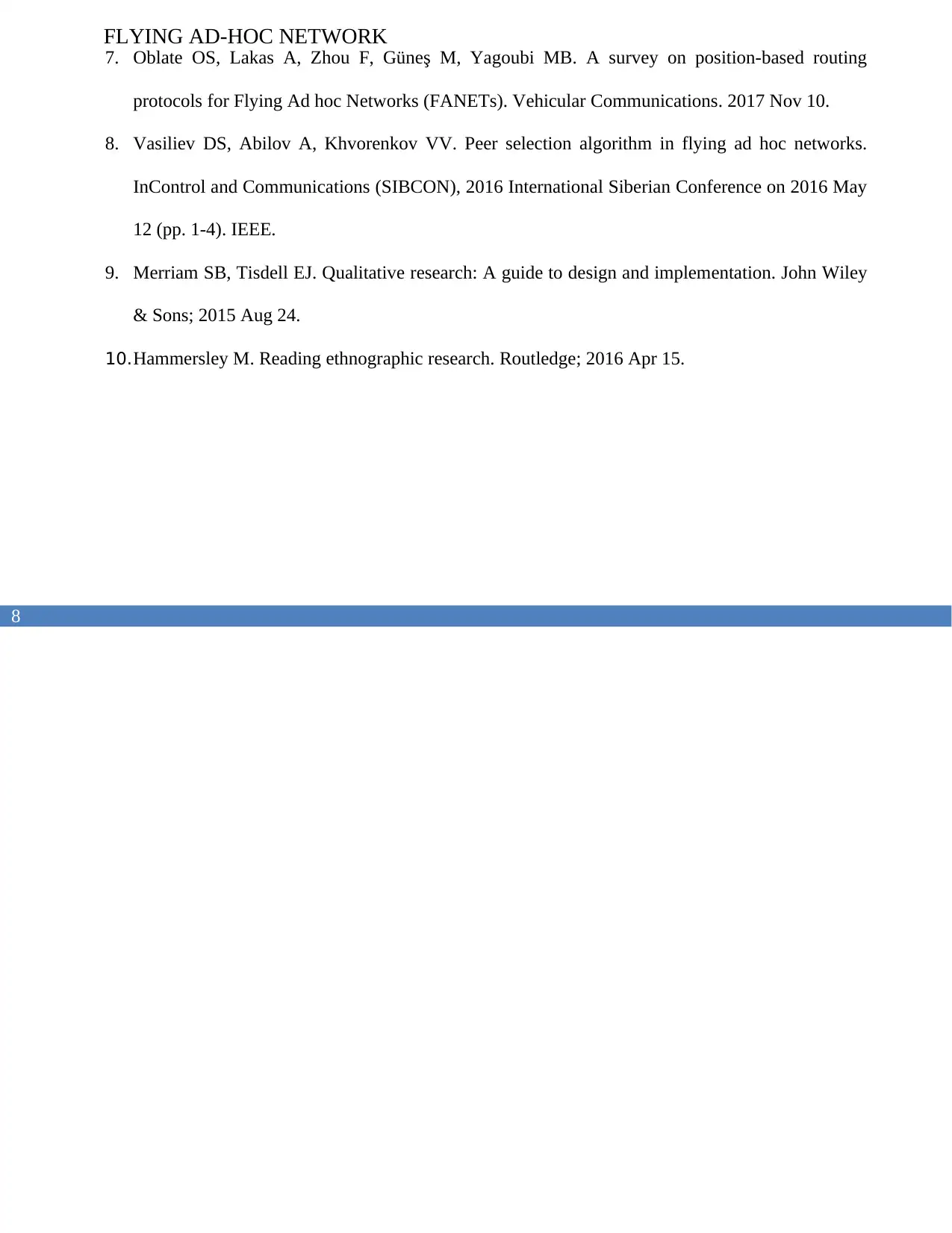
FLYING AD-HOC NETWORK
8
7. Oblate OS, Lakas A, Zhou F, Güneş M, Yagoubi MB. A survey on position-based routing
protocols for Flying Ad hoc Networks (FANETs). Vehicular Communications. 2017 Nov 10.
8. Vasiliev DS, Abilov A, Khvorenkov VV. Peer selection algorithm in flying ad hoc networks.
InControl and Communications (SIBCON), 2016 International Siberian Conference on 2016 May
12 (pp. 1-4). IEEE.
9. Merriam SB, Tisdell EJ. Qualitative research: A guide to design and implementation. John Wiley
& Sons; 2015 Aug 24.
10.Hammersley M. Reading ethnographic research. Routledge; 2016 Apr 15.
8
7. Oblate OS, Lakas A, Zhou F, Güneş M, Yagoubi MB. A survey on position-based routing
protocols for Flying Ad hoc Networks (FANETs). Vehicular Communications. 2017 Nov 10.
8. Vasiliev DS, Abilov A, Khvorenkov VV. Peer selection algorithm in flying ad hoc networks.
InControl and Communications (SIBCON), 2016 International Siberian Conference on 2016 May
12 (pp. 1-4). IEEE.
9. Merriam SB, Tisdell EJ. Qualitative research: A guide to design and implementation. John Wiley
& Sons; 2015 Aug 24.
10.Hammersley M. Reading ethnographic research. Routledge; 2016 Apr 15.
1 out of 9
Related Documents
Your All-in-One AI-Powered Toolkit for Academic Success.
+13062052269
info@desklib.com
Available 24*7 on WhatsApp / Email
![[object Object]](/_next/static/media/star-bottom.7253800d.svg)
Unlock your academic potential
© 2024 | Zucol Services PVT LTD | All rights reserved.





